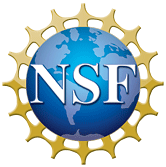CASPER REU Program
CASPER Research Experience for Undergraduates (REU) Program
CASPER's REU Program offers outstanding undergraduates an opportunity for active research participation with Baylor University faculty in the Center for Astrophysics, Space Physics & Engineering Research.
CASPER consists of independent groups that conduct theoretical, numerical, and experimental in work in various research fields within physics as represented by the CASPER Star Diagram.
Program Specifics
- Ten-week program beginning around the end of May and ending around the beginning of August.
- Fellows are paid a $5000 stipend, $1000 housing allowance and $400 toward travel expenses.
Research Opportunities for REUs
Dusty Plasma Lab (experimental & theoretical)
Order and stability in the world of stars and galaxies is dominated by the force of gravity. In contrast, the tiny world of atomic and subatomic particles is held together by nuclear and quantum forces. As one sizes up from the subatomic to the astronomical scales, a natural question emerges: What fundamental principles govern the world of the "in-between?" In other words, what happens to the laws of nature when the time and spatial scales change from large to small? The physics of dusty plasmas provides possible solutions to these fundamental questions. It also explores the fascinating world of naturally occurring dusty plasmas both in the Solar System and beyond.
Research Topics in Dusty Plasma
- Visualizing Matter – How do small systems (~1000 particles or less) self-organize and stabilize in gravity and microgravity? How are the dynamics changed in non-equilibrium systems? How about when the system is being driven by constantly adding energy to it? How can dusty plasmas be used to study the onset of turbulence in complex liquids, where both defects and nonlocal effects are present?
- Cosmic Dust – How does cosmic dust clump together to start forming planets? How can the structure of these dust clumps be inferred from the observed structure of meteoritic rocks (chondrule dust rims)? How is dust on the moon or other airless (or thin-atmosphere) bodies transported?
- Dust Diagnostics & Control – How can we use the motion of dust particles, which we can see, to tell us about electrons and ions in the plasma, which we can’t see? How can we design dust detectors for space missions to learn more about cosmic dust and to protect satellites and space missions?
Early Universe Cosmology and Superstrings (theoretical)
According to Einstein's theory of general relativity, the force of gravity is caused when massive objects bend space-time. The most recent confirmation of this theory was the discovery of gravitational waves, which are traveling curvatures of space-time. Despite its success, general relativity is formulated using the principles of classical physics, while the other fundamental forces (electromagnetic, weak nuclear and strong nuclear forces) are described by quantum mechanics and quantum field theory. Quantum gravity is the field of physics that aims to develop a framework where gravity is defined using the principles of the quantum world.
Research Topics in Early Univers
- Quantum Cosmology – How did quantum gravity shape structures in the early stages of our Universe’s life? Can any of these effects be detected in present-day observations? What experiments can be designed to confirm theories such as the Loop Quantum Gravity?
- Gravitational Wave Astronomy – What current and future experiments can be designed to detect the so-called primordial gravity waves, which are believed to have occurred in the very early Universe due to quantum fluctuations of space-time.
- Superstring Theory – Can we model gravity in the framework of vibrating supersymmetric strings? Does superstring theory provide a unification of all fundamental forces? What experiments can be designed to validate such unification?
Eligibility and Selection Criteria
Any college undergraduate who has completed their freshman year and who is interested in pursuing a career in the physical sciences is eligible.
Applicants will be considered for appointment without regard to race, creed, color, sex, national origin, age, handicap status or any other non-merit factor. Appointment selection is competitive on a national scale and will be based upon:
- Scholarship, curriculum and experience;
- Career objectives and scientific interest;
- Match of applicant interest to available research projects; and
- Letters of recommendation.
Application Process
Registration for the REU program is now closed!
Awardees will be notified by email of their acceptance into the program and must acknowledge receipt of this email no later than five days from the date it is sent. For final confirmation of appointment, successful applicants must sign a letter of acceptance (or rejection) of the offer to participate within one (1) week of their receipt of the email notification.
Program / Logistics / Application Questions?
Dr. Truell W. Hyde, Director
CASPER
BRIC 3103.04
100 Research Pkwy
Waco, Texas 76704
(254) 710-6717 (Voice)
(254) 710-3388 (Fax)
Truell_Hyde@baylor.edu



